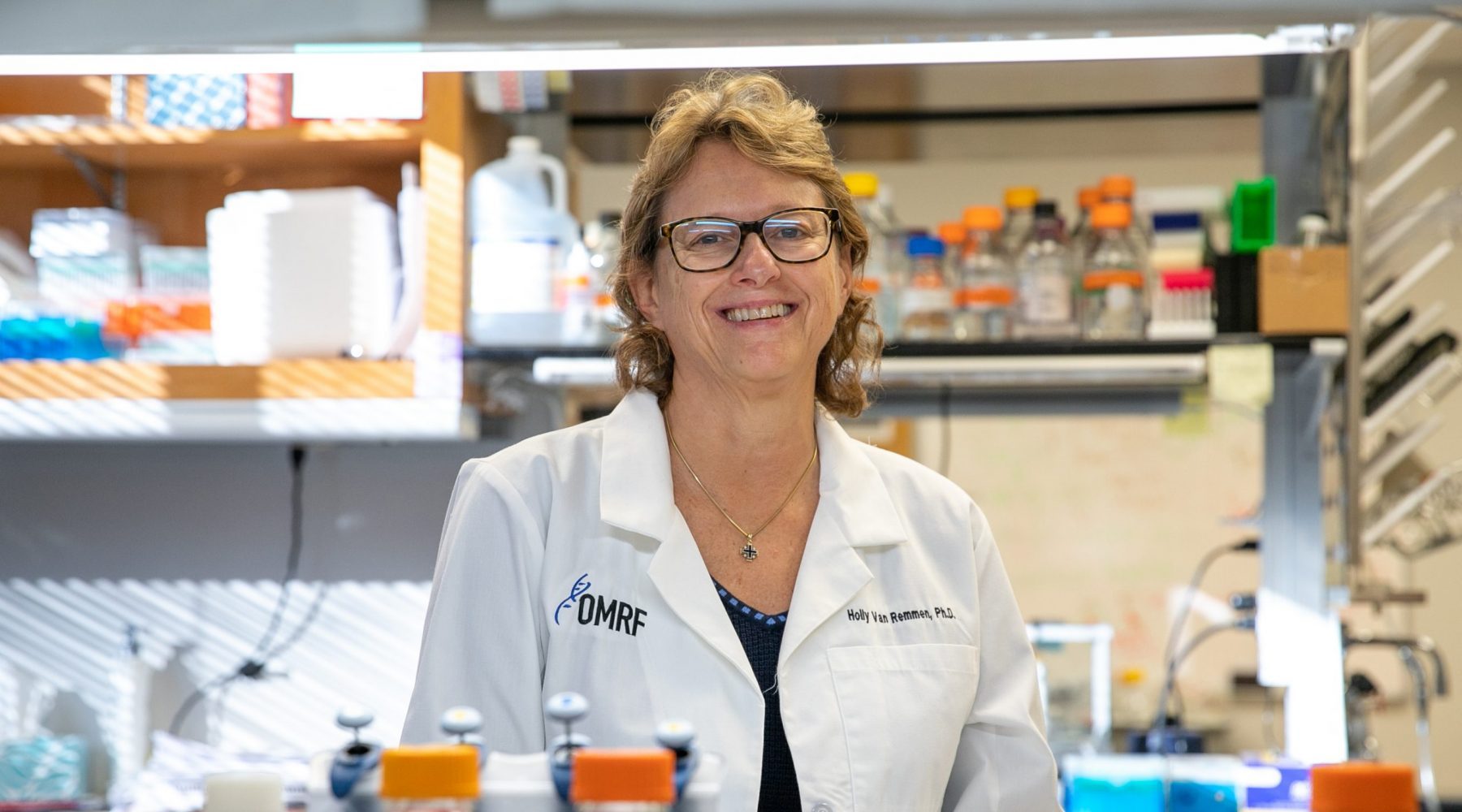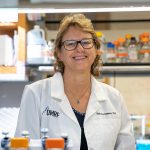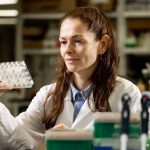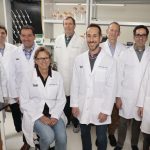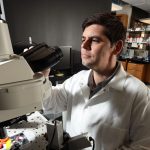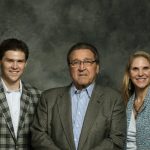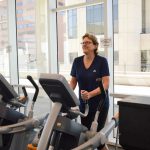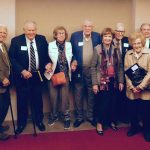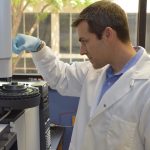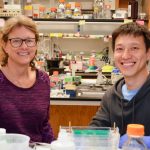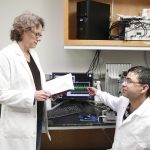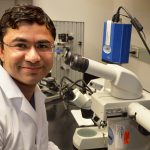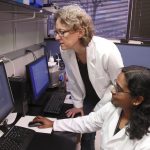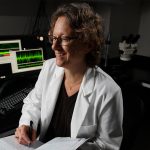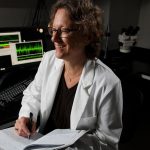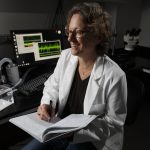Holly Van Remmen, Ph.D.
Professor
Aging & Metabolism Research Program
My 101
In the year 1900, the average U.S. lifespan was 46 years for men and 48 years for women. In 2013, the average was 76 for men and 81 for women. Advances in medical science and human health have people living longer, but new challenges arise with an extended lifespan.
Research in my lab focuses on aging. One question we’re keen to answer is: Why do people lose muscle as they get older? It’s a normal part of aging, but it bears similarity to a disease called sarcopenia, in which the body loses skeletal muscle mass. Using a mouse model of sarcopenia, we’re looking specifically at the role of oxidative stress, or free radicals, in the long-term deterioration of muscle. As part of this research, we are studying how mitochondria are affected by aging and might contribute to aging. Mitochondria are present in all cells and are responsible for generating energy and controlling metabolism and also for producing the majority of oxidative stress as a by-product of their function.
Another disease in which oxidative stress affects muscles is amyotrophic lateral sclerosis, often called ALS or Lou Gehrig’s disease. In ALS, a group of cells called motor neurons is affected, reducing a patient’s ability to control their muscles. We also use a mouse model of ALS to study how the loss of an enzyme affects motor neurons.
Importantly , we are now testing potential interventions to reduce or delay loss of muscle and weakness in aging and motor neuron degeneration in aging and ALS. We hope to move some of our findings to the clinic in the future. Our goal is not to find a “fountain of youth,” but to address the declining quality of life as we age. It’s important that our “healthspan” matches our lifespan.
Research
My research program has focused on the role of oxidative stress and mitochondrial function in aging. We utilized a number of transgenic and knockout models with modified antioxidant defense systems to ask whether changes in antioxidant defense and oxidative stress modify lifespan as predicted by the long-standing Oxidative Stress Theory of Aging. In contrast to the predictions of this Theory, our studies have shown that modifying antioxidant defenses does not alter lifespan. These studies suggest that oxidative stress may not be a primary factor underlying aging per se. However, we propose the oxidative stress is indeed a critical factor in age-associated diseases such as sarcopenia and Amyotrophic Lateral Sclerosis (ALS). Our recent work has focused on the role of mitochondria and oxidative stress on alterations in the motor neurons, the neuromuscular junction and skeletal muscle that might contribute to the significant problem of age-related loss of muscle mass and may have implications for onset and progression of ALS. In another line of research, we are studying the role of the mitochondrial unfolded protein response (mtUPR) in aging and the potential for tissue cross-talk based on mitochondrial signaling that might influence changes in metabolism. As part of these studies, we are interested in studying age related changes in components of the mtUPR such as heat shock proteins and mitochondrial proteases Lon and ClpP.
Brief CV
Education
B.S. Eastern Illinois University, Charleston, IL, 1983
Ph.D. University of Texas Health Science Center, San Antonio, TX, 1991
Postdoc UTHSC, San Antonio, TX, with Arlan Richardson, Ph.D., 1991-1995
Honors and Awards
Proctor and Gamble Professional Opportunity Award, American Physiologic Society, 1988
Graduate Studies in Physiology Award for Excellence, Graduate School of Biomedical Sciences, University of Texas Health Science Center at San Antonio, 1990
Sacher Graduate Student Award, Biological Sciences, Gerontological Society of America, 1991
Geriatric Leadership Academic Award, Aging Research and Education Center, University of Texas Health Science Center at San Antonio, 1992
Geriatric Leadership Academic Award, Aging Research and Education Center, University of Texas Health Science Center at San Antonio, 1994
American Federation for Aging Research Award, 1995
Dielmann Distinguished Endowed Chair in Aging, 2007
Ellison Medical Foundation Senior Scholar, 2010
Memberships
American Physiological Society, 1984-present
Oxygen Society/Society for Free Radical Biology in Medicine, 1997-present
San Antonio Cancer Institute, 1999-2009
American Aging Association, Member/Board Member, 2000-present; President 2022-2023
Joined OMRF’s scientific staff in 2013
Publications
Recent Publications
Kurien BT, Ice JA, Wood RA, Pharaoh G, Cavett J, Lewis V, Bhaskaran S, Rasmussen A, Lessard CJ, Farris AD, Sivilis K, Koelsch KA, Van Remmen H, Scofield RH. Mitochondrial dysfunction and fatigue in Sjögren's disease. RMD Open 11, 2025 April, PMID: 40274303, PMCID: PMC12020762
Nyul-Toth A, Shanmugarama S, Patai R, Gulej R, Faakye J, Nagy D, Nagykaldi M, Kiss T, Csipo T, Milan M, Ekambaram S, Negri S, Nagaraja RY, Csiszar A, Brown JL, Van Remmen H, Ungvari A, Yabluchanskiy A, Tarantini S, Ungvari Z. Endothelial IGF- 1R deficiency disrupts microvascular homeostasis, impairing skeletal muscle perfusion and endurance: implications for age-related sarcopenia. Geroscience, 2025 April, PMID: 40199795
Brown JL, Xu H, Duggan E, Rosenfeld CS, Van Remmen H. Pharmacological reduction of lipid hydroperoxides as a potential modulator of sarcopenia. J Physiol, 2025 January, PMID: 39777675, PMCID: PMC12042244
Selected Publications
Muscle Mitochondrial Catalase Expression Prevents NMJ Disruption, Atrophy and Weakness in a Mouse Model of Accelerated Sarcopenia. Hongyang Xu, Rojina Ranjit, Arlan Richardson and H. Van Remmen. J Cachexia Sarcopenia Muscle. Accepted.
Piekarz KM, Bhaskaran S, Sataranatarajan K, Street K, Premkumar P, Saunders D, Zalles M, Gulej R, Khademi S, Laurin J, Peelor R, Miller BF, Towner R, Van Remmen H. Molecular changes associated with spinal cord aging. Geroscience. 2020 Apr;42(2):765-784. doi: 10.1007/s11357-020-00172-6. Epub 2020 Mar 6.PMID: 32144690, PMCID: PMC7205981
Pharaoh G, Brown JL, Sataranatarajan K, Kneis P, Bian J, Ranjit R, Hadad N, Georgescu C, Rabinovitch P, Ran Q, Wren JD, Freeman W, Kinter M, Richardson A, Van Remmen H. Targeting cPLA2 derived lipid hydroperoxides as a potential intervention for sarcopenia. Scientific Reports. 2020 Aug 18;10(1):13968. doi: 10.1038/s41598-020-70792-7.PMID: 32811851, PMCID: PMC7435184
Ahn B, Ranjit R, Premkumar P, Pharaoh G, Piekarz KM, Matsuzaki S, Claflin DR, Riddle K, Judge J, Bhaskaran S, Satara Natarajan K, Barboza E, Wronowski B, Kinter M, Humphries KM, Griffin TM, Freeman WM, Richardson A, Brook SV, Van Remmen H. Mitochondrial oxidative stress impairs contractile function but paradoxically increases muscle mass via fiber branching. J Cachexia Sarcopenia Muscle. 10:411-428, 2019. PMID: 30706998, PMCID: PMC6463475
Bhaskaran S, Pollock N, C Macpherson P, Ahn B, Piekarz KM, Staunton CA, Brown JL, Qaisar R, Vasilaki A, Richardson A, McArdle A, Jackson MJ, Brooks SV, Van Remmen H. Neuron-specific deletion of CuZnSOD leads to an advanced sarcopenic phenotype in older mice. Aging Cell. 2020 Sep 4:e13225. doi: 10.1111/acel.13225. Online ahead of print. PMID: 32886862, PMCID: PMC7576239
Jang, Y.C., Liu, Y., Hayworth, C.R., Bhattacharya, A., Lustgarten, M.S., Muller, F.L., Chaudhuri, A., Qi, W., Li, Y., Huang, J.Y., Verdin, E., Richardson, A. and Van Remmen, H. Dietary restriction attenuates age- associated muscle atrophy by lowering oxidative stress in mice even in complete absence of CuZnSOD. Aging Cell 11:770-82 2012. PMID: 22672615, PMCID: PMC3444532
Contact
Aging & Metabolism Research Program, MS 46
Oklahoma Medical Research Foundation
825 N.E. 13th Street
Oklahoma City, OK 73104
Phone: (405) 271-2520
Fax: (405) 271-3470
E-mail: holly-vanremmen@omrf.org
For media inquiries, please contact OMRF’s Office of Public Affairs at news@omrf.org.
Lab Staff
Jacob Brown, Ph.D.
Research Assistant Member
Hongyang "Yang" Xu, Ph.D.
Postdoctoral Scientist
Elizabeth Duggan
Research Technician III
Jessica Thomason
Research Technician II
Bo Hagy
Research Technician
Kara Kneuper
Research Technician
Ashley Murphy
Senior Laboratory Technician
Tamy Aguero Fraire
Laboratory Assistant
Jeannie Evans
Project Coordinator II
Tracy Cardinal
Administrative Assistant III
Holly Smith
Administrative Assistant III
News from the Van Remmen lab
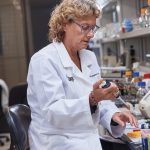
August For Dr. Holly Van Remmen, “research is a puzzle.” As a child, Holly Van Remmen loved to figure out how things worked. Even her younger sister’s supposedly impregnable Fisher-Price transistor radio fell prey to her inquiring mind. “I used butter knives, screwdrivers and all kinds of things to get inside it,” she says. “I just […]

2020 had many downsides. But for Dr. Benjamin Miller, a year devoid of social engagements and work-related travel brought an unexpected gift: more time on his bike. A former elite amateur cyclist, Miller gets up before dawn most mornings to ride. He estimates he spends 10 to 15 hours cycling in a typical week, which […]

Under his leadership, OMRF has enjoyed a decade of scientific achievement and historic campus expansion. Still, if you ask Dr. Stephen Prescott, he’ll tell you he’s just getting started. For Dr. Stephen Prescott there was no aha! moment. No instant where everything crystallized and he just knew he had to take the helm of […]
